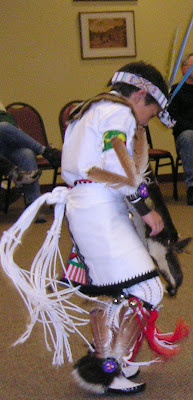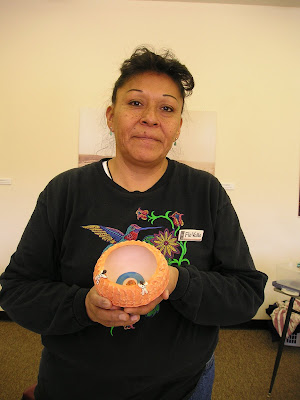The Pueblo Cultural Center, Albuquerque New Mexico
The Pueblo Cultural Center, Albuquerque New Mexico
[This is the second in a series of articles about educational trips with children in the Southwestern United States, and particularly Indian country. Vera Marie Badertscher has lived in the Southwest for more than 40 years, and for the past ten years has traveled extensively in Arizona and New Mexico and she and Charnell Havens researched the book Quincy Tahoma: The Life and Legacy of a Navajo Artist.]
One of the most cultural rich and interesting areas in the United States follows the Rio Grande River of New Mexico. A string of pueblos there greeted Spanish explorers and nineteen of them still thrive today.
Before setting out for the pueblos, a visit to the Pueblo Cultural Center in Albuquerque, will set the stage for exploring these villages of living history. The Pueblo people, like all American Indians, want you to understand that although they live in historic places, they are modern people. Randy Pedro, who worked at the Pueblo Cultural Center, told me that she wants visiting children to know, “We (Pueblo Indians) did not go away. We are still here and continue to do the things we did in the past.”
Pueblo Indians believe they emerged from under the ground in a place somewhere near Mesa Verde, Colorado. To help you visualize that belief, the museum layout starts in a dark space that tells the emergence legend. Then a path through the museum progresses through prehistoric hunting, languages, migration patterns, religious beliefs, and food of the surviving 19 pueblos.
As you walk through the exhibits, you are surrounded by pueblo architecture with walls of stone and adobe. The floor resembles small pebbles beat into pathways by centuries of feet dancing, grinding corn, or making pottery. Frequently demonstrators help visitors try their hand at making pottery or baking Indian bread the way it has always been done.
“Children want to know everything if not more.” When asked what kids particularly like, my guide told me, “Children like the 'stuff'—turkey feather blankets, weapons." When there are how-to demonstrations,children particularly like the simple hands-on weaving. Their imaginations get full rein in the Children’s House, a separate hands-on children's building where children can put on clothing, use tools and implements and pretend to be Puebloans.

Pueblo child dancer
Most of the year people gather outdoors on the Plaza of the cultural center at noon on Saturdays and Sundays to watch authentic Pueblo dancers. In bad weather, the dances move indoors. Children watching the dances become very still, even toddlers mesmerized by the rhythmic drum beats and shaking rattles. Both adult and child dancers wear elaborate and colorful costumes. Many times the men and boys have seed pods tied to their leggings so that as they step, they create their own rhythm section. Tall headresses represent corn or rain or animals. Beads, turquoise and silver jewelry and bits of feathers and bright ribbons adorn woven cotton dresses and shirts. Every design and piece of costume holds meaning.
The leader of the dance group explains the dance that is coming and its purpose. People in the audience eagerly cluster around the dancers after the show to talk to them and learn more about the meaning of the costumes. These dances are adaptations of actual religious dances, and are seen as performances rather than rituals.
While it is possible to see various pueblos represented at the Indian Cultural Center, families can also visit the actual Pueblos on special days. The dances you may see at the Pueblos are not performances. They are religious rituals, so it is important to be respectful. The Pueblo communities ask that you turn off cell phones, take no photographs, notes or sketches. Since it is not a performance, when it is held in the pueblo, it is not appropriate to talk to the dancers or to applaud. The Indian Pueblo Cultural Center or their web site provides a schedule of Pueblo dances that welcome visitors.
Tip: If you want to buy a bona fide piece of Indian pottery or real turquoise and silver jewelry, one of the best places to assure authenticity will be the cluster of shops at the Pueblo Cultural Center.

Pueblo Potter Flo Vallo
If you are in New Mexico, be sure to take advantage of the opportunity to visit Acoma Pueblo or one of the pueblos of the Rio Grande Valley. In Arizona, the Hopi pueblos occupy a high plateau in the middle of the Navajo reservation. Most have guided tours and you can learn a lot from the guides. Do not be afraid to ask questions of people you meet, but please observe the same courtesy you would if strolling through a neighborhood in your own town.
Note: The Pueblo Cultural Museum is on the list of free (one weekend a month) museums for people with Bank of America Cards with the Museums on Us Program.
You can see an article by Vera Marie Badertscher about her experience with Pueblo Culture at Your Life Is A Trip. Learn more about her book about Navajo artist Quincy Tahoma at http://tahomablog.com or http://tahoma.info.
All photos courtesy and copyright Vera Marie Badertscher. All photos were taken at the Pueblo Cultural Center.
-

- Log in to post comments



















